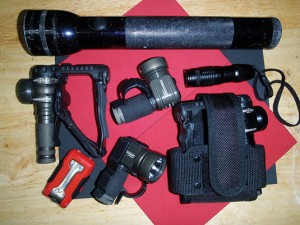
The author’s collection of work flashlights he currently uses — with the exception of the three-cell Maglite at the top. It’s circa 1983, was carried for decades in the driver’s side door compartment of his work vehicle, and is retired from service. Photo: Jeff McGovern
Flashlights were used regularly in the early 1900s. The name came from the fact that batteries were short-lived and could only be used for a few moments at a time, flashing the light where needed.
From the beginning, pest management professionals (PMPs) needed this technology to perform their jobs. It enabled them to track pests and their resources better than any other lighting tool available. Flashlights freed them from the restrictions of an extension cord, and the clumsiness of a work light.
I began my career in the pest control industry in the early 1970s. At the time, I was issued the industry standard flashlight: a brightly colored, plastic 2D cell light and a leather belt holder. It was expected that the light and holder were as much a part of the uniform as the shirt and slacks. The light was sturdy for its day, but extra batteries were a necessity, as were spare bulbs because dropping the light could easily break the filament in the bulb. A set of batteries and a spare bulb were always close at hand.
Enhancement evolution
In 1979, a company in California developed the first professional flashlight with a machined aluminum body. It was marketed to the police, military and trades, such as the pest management market. Even though there were still bulb changes and batteries, the light was a vast improvement compared to its predecessors. It also featured a protected spare bulb compartment in the base cap, and the light could be focused by twisting the front lens cap.
The next significant improvement was the bulbs, which produced a brighter, more uniform light. Gases inside the bulb, such as halogen or xenon, cooled the filament, allowing it to burn brighter.
Aluminum-bodied flashlights underwent tremendous development through the late 1980s and into the late 1990s. Smaller, more powerful lights hit the market, and prices escalated for professional-grade, handheld lighting.
In the early part of this century, light-emitting diodes (LEDs) began to replace bulbs as the source of light. Gradually, LEDs surpassed bulb technology, allowing for more powerful handheld lighting that could withstand a serious beating in the professional world. Instead of a bulb’s burn time of about 50 hours, LEDs last for thousands of hours — in some cases, never requiring replacement in an entire career. Battery life now can be measured in days, not flashes. Rechargeable batteries and primary cells are more dependable than anything we’ve used before.
Today’s flashlights can have multiple brightness levels, various colors of light (including ultraviolet, or UV) and features such as strobe or remote control, all built into the same handheld package. They’re tough, shock- and water-resistant, and have the ability to produce a beam that can light an entire crawlspace or attic. In fact, sometimes the light can be too much of a good thing. I recommend using a light with adjustable brightness that is dimmer when turned on, but can be made brighter with a single stroke.
You can reach Jeff McGovern at jeffreymcgovern@mindspring.com.
Leave A Comment